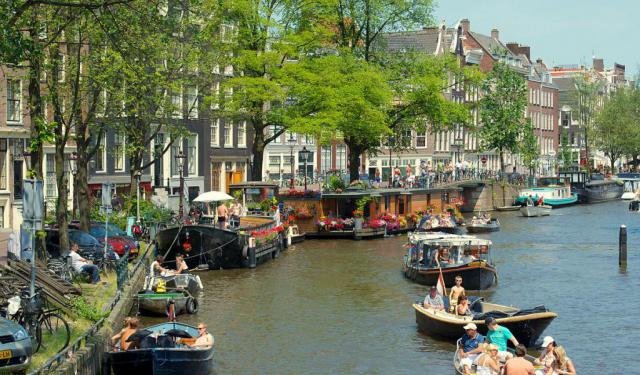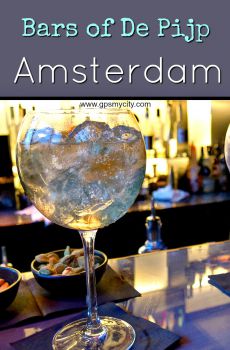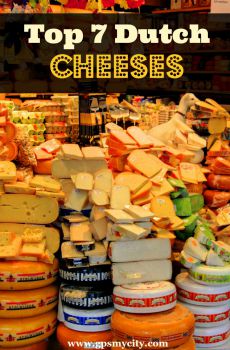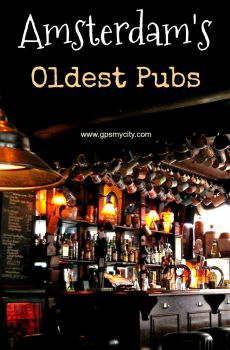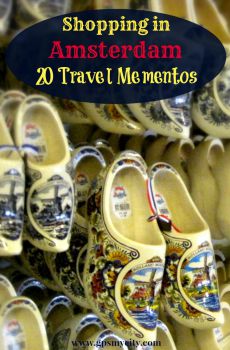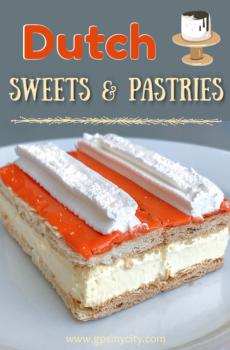
Southern Canal Belt Walking Tour (Self Guided), Amsterdam
The Canal District, known as Grachtengordel in Dutch, is a globally renowned example of urban planning and architectural excellence within Amsterdam. This area has remained remarkably well-preserved for over four centuries, celebrated for its charming small bridges, canal crossings, and 17th-century residences. Encircling the Old City Centre in a horseshoe shape, the Canal Ring encompasses three main canals: Herengracht, Keizersgracht, and Prinsengracht, all constructed during Amsterdam's prosperous Golden Era.
Interconnected with charming streets, these three canals provide a wide array of shopping, dining, and drinking opportunities, accompanied by a rich cultural scene. Notable attractions include the Pipe Museum, the Cat Cabinet, the Photography Museum (FOAM), the Mint Tower, and more. Exploring the Amsterdam Canal Belt by foot is an exceptional and unmissable experience when visiting Amsterdam.
Interconnected with charming streets, these three canals provide a wide array of shopping, dining, and drinking opportunities, accompanied by a rich cultural scene. Notable attractions include the Pipe Museum, the Cat Cabinet, the Photography Museum (FOAM), the Mint Tower, and more. Exploring the Amsterdam Canal Belt by foot is an exceptional and unmissable experience when visiting Amsterdam.
How it works: Download the app "GPSmyCity: Walks in 1K+ Cities" from Apple App Store or Google Play Store to your mobile phone or tablet. The app turns your mobile device into a personal tour guide and its built-in GPS navigation functions guide you from one tour stop to next. The app works offline, so no data plan is needed when traveling abroad.
Southern Canal Belt Walking Tour Map
Guide Name: Southern Canal Belt Walking Tour
Guide Location: Netherlands » Amsterdam (See other walking tours in Amsterdam)
Guide Type: Self-guided Walking Tour (Sightseeing)
# of Attractions: 10
Tour Duration: 2 Hour(s)
Travel Distance: 3.1 Km or 1.9 Miles
Author: clare
Sight(s) Featured in This Guide:
Guide Location: Netherlands » Amsterdam (See other walking tours in Amsterdam)
Guide Type: Self-guided Walking Tour (Sightseeing)
# of Attractions: 10
Tour Duration: 2 Hour(s)
Travel Distance: 3.1 Km or 1.9 Miles
Author: clare
Sight(s) Featured in This Guide:
- Munttoren (Mint Tower)
- Bloemenmarkt (Floating Flower Market)
- De Kleine Komedie
- KattenKabinet (Cat Cabinet)
- Leidsestraat
- Pipe Museum
- Nieuwe Spiegelstraat
- FOAM (Fotografiemuseum Amsterdam)
- Museum Van Loon
- Magere Brug (Skinny Bridge)
1) Munttoren (Mint Tower)
This tower served as both a boundary marker for the medieval walled city and one of its original gates. Back in the Middle Ages, the city walls were surrounded by a moat known as the Singel canal. Prior to around 1500, the area beyond this point was essentially just soggy fields and a handful of farms on reclaimed land. The steeple was actually added later, in 1620, as you can see below the clock face.
Erected during the latter part of the 15th century, the tower underwent significant renovations throughout the centuries. It managed to survive a big fire in 1618, which destroyed most of the city's walls, almost unscathed; however, it was rebuilt in the Renaissance style the following year. Hendrick de Keyser, a renowned Dutch architect and sculptor, was in charge of the reconstruction and added the elegant eight-sided top section. They also incorporated four clock faces and a set of bells, although the original bells are now on display in the Amsterdam Museum, having been replaced with newer ones. The tower chimes every quarter of an hour, and on Saturdays between 2 and 3pm, you can enjoy a live bell concerto.
The construction got its curious name in the 17th century during a time when the Dutch were in conflict with England and France. Since most of Dutch territory was occupied and there was a high risk of losing valuable resources, they needed a place to make money quickly, so they turned this tower into a makeshift mint. And that's how its uniqueness became etched into Amsterdam's rich tapestry of stories.
Erected during the latter part of the 15th century, the tower underwent significant renovations throughout the centuries. It managed to survive a big fire in 1618, which destroyed most of the city's walls, almost unscathed; however, it was rebuilt in the Renaissance style the following year. Hendrick de Keyser, a renowned Dutch architect and sculptor, was in charge of the reconstruction and added the elegant eight-sided top section. They also incorporated four clock faces and a set of bells, although the original bells are now on display in the Amsterdam Museum, having been replaced with newer ones. The tower chimes every quarter of an hour, and on Saturdays between 2 and 3pm, you can enjoy a live bell concerto.
The construction got its curious name in the 17th century during a time when the Dutch were in conflict with England and France. Since most of Dutch territory was occupied and there was a high risk of losing valuable resources, they needed a place to make money quickly, so they turned this tower into a makeshift mint. And that's how its uniqueness became etched into Amsterdam's rich tapestry of stories.
2) Bloemenmarkt (Floating Flower Market)
When you visit Amsterdam, especially during the springtime, you won't want to miss out on seeing some beautiful tulips. Even if they haven't fully bloomed or are past their prime, fear not – Bloemenmarkt has got you covered. This place has been around since the 1860s and is arguably the best, and still the most atmospheric, spot to discover (and buy) fresh flowers and bulbs.
As soon as you enter this little botanical wonderland situated along the canal, you'll be surrounded by all things floral (and sometimes more) – there's a dazzling array of souvenirs, and surprisingly, they're priced pretty much the same across various vendors. You can find a wide variety of bulbs for sale, including daffodils, amaryllis, crocus, narcissus, tulips, peony roots, and more. They even have some cacti and potted plants and herbs available for purchase.
Tip:
It you decide to buy tulip bulbs to take back home, be sure to get a "customs-cleared" stamp to avoid any issues with customs when upon arrival in your home country.
As soon as you enter this little botanical wonderland situated along the canal, you'll be surrounded by all things floral (and sometimes more) – there's a dazzling array of souvenirs, and surprisingly, they're priced pretty much the same across various vendors. You can find a wide variety of bulbs for sale, including daffodils, amaryllis, crocus, narcissus, tulips, peony roots, and more. They even have some cacti and potted plants and herbs available for purchase.
Tip:
It you decide to buy tulip bulbs to take back home, be sure to get a "customs-cleared" stamp to avoid any issues with customs when upon arrival in your home country.
3) De Kleine Komedie
If you're into Dutch cabaret-theatre, the Kleine Komedie is a fantastic venue that showcases the lively and creatively satirical scene in the Netherlands. It's also housed in Amsterdam's oldest surviving theater building, which dates back to 1788. Back in the 1950s and 60s, many Dutch entertainment legends, including Toon Hermans, Wim Kan, and Fons Jansen, graced its stage.
In 1973, the building faced a temporary closure due to fire safety concerns raised by the Amsterdam fire brigade. However, it made a triumphant return in 1978 after undergoing renovations funded by private sources.
Today, the Kleine Komedie continues to provide an intimate setting for emerging and established Dutch talents. Occasionally, they also host a few comedy shows in English and feature musical performances.
Tip:
Just a few doors down on Amstel, you'll find Mulligan’s Irish Music Bar, where the music and atmosphere are so authentically Irish that you might feel like you're sipping a pint of Guinness in Dublin.
In 1973, the building faced a temporary closure due to fire safety concerns raised by the Amsterdam fire brigade. However, it made a triumphant return in 1978 after undergoing renovations funded by private sources.
Today, the Kleine Komedie continues to provide an intimate setting for emerging and established Dutch talents. Occasionally, they also host a few comedy shows in English and feature musical performances.
Tip:
Just a few doors down on Amstel, you'll find Mulligan’s Irish Music Bar, where the music and atmosphere are so authentically Irish that you might feel like you're sipping a pint of Guinness in Dublin.
4) KattenKabinet (Cat Cabinet)
Dubbed the "Golden Bend", owing to the opulent provenance of its initial denizens, the expanse of the Herengracht extending betwixt Vijzelstraat and Leidsestraat exudes an aura of grandiosity. Within this domain, one shall encounter an array of mansions adorned with ornate sandstone façades, in lieu of the more economical brick construction. Notable among these resplendent abodes is #475, characterized by its embodiment of Louis XIV-style opulence, oft regarded as the most splendid domicile in all of Amsterdam. Additionally, #476, meticulously revamped during the 1730s and crowned with the regal emblem of an eagle, commands admiration.
A venture further along this thoroughfare shall unveil the enigmatic #497, a site accessible to the public with a predilection for feline enthusiasts. This peculiar establishment is none other than the KattenKabinet, a museum of unparalleled singularity, housing a substantial collection of artistic masterpieces and artifacts wholly dedicated to the venerable cat. This institution was conceived by a Dutch financier, driven by his profound adoration for his cherished feline companion, John Pierpont Morgan, an homage to the American financier, whose earthly tenure concluded in the year 1984. To those whose hearts are entwined with these enigmatic creatures, the Cat Cabinet shall prove a veritable sanctuary of enchantment and captivation.
A venture further along this thoroughfare shall unveil the enigmatic #497, a site accessible to the public with a predilection for feline enthusiasts. This peculiar establishment is none other than the KattenKabinet, a museum of unparalleled singularity, housing a substantial collection of artistic masterpieces and artifacts wholly dedicated to the venerable cat. This institution was conceived by a Dutch financier, driven by his profound adoration for his cherished feline companion, John Pierpont Morgan, an homage to the American financier, whose earthly tenure concluded in the year 1984. To those whose hearts are entwined with these enigmatic creatures, the Cat Cabinet shall prove a veritable sanctuary of enchantment and captivation.
5) Leidsestraat
This busy main shopping thoroughfare is always packed because it connects one of the city's biggest and liveliest squares, Leidseplein, to the central area. Think of it as the fancier version of Kalverstraat, offering a diverse range of reasonably priced designer clothing and shoe boutiques. Plus, there are tons of cool canal-side cafés and restaurants from all over the world (such as Maoz Vegan, La Place Express, or Villa Maria Steakhouse, to name just a few), some of which are so popular that you better make a reservation.
At the corner of Keizersgracht, you can't miss the Abercrombie & Fitch store at #32 housed within a magnificent stone building dating back to 1891, with fancy columns ("caryatids") on the front and a distinctive corner dome. Notably, during its construction, this was the tallest commercial structure in town, which is why they convinced the famous architect Gerrit Rietveld (1888–1964), a leading figure in the De Stijl artistic movement, to add a glass-and-metal showroom on the roof in 1933 (you can still spot it from the street today).
It's worth noting that the street was planned way back in the 17th century, and the old houses still carry the grandeur of their past glory. So, even if shopping isn't your thing, you'll discover plenty to pique your curiosity. And if you wander nearby, you'll stumble upon the Spiegelkwartier, which is basically a super famous spot in Europe for antiques.
At the corner of Keizersgracht, you can't miss the Abercrombie & Fitch store at #32 housed within a magnificent stone building dating back to 1891, with fancy columns ("caryatids") on the front and a distinctive corner dome. Notably, during its construction, this was the tallest commercial structure in town, which is why they convinced the famous architect Gerrit Rietveld (1888–1964), a leading figure in the De Stijl artistic movement, to add a glass-and-metal showroom on the roof in 1933 (you can still spot it from the street today).
It's worth noting that the street was planned way back in the 17th century, and the old houses still carry the grandeur of their past glory. So, even if shopping isn't your thing, you'll discover plenty to pique your curiosity. And if you wander nearby, you'll stumble upon the Spiegelkwartier, which is basically a super famous spot in Europe for antiques.
6) Pipe Museum
This quirky but classy little museum houses 300 years' worth of pipes in a 17th-century canal house. Honestly, it's almost worth the entrance fee just to get a peek inside one of these fancy homes. You start your visit in the shop on the street level, and it's so fascinating it could be a museum all on its own. They sell both new and antique pipes, all sorts of smoking-related knick-knacks, and books written by the shop's owner for the true enthusiasts. If you're up for it, you can pay a little extra to enter the museum, and a friendly volunteer guide will take you upstairs for a journey through the history of smoking. You'll get to see pre-Columbian terra-cotta pipes (from the folks who discovered tobacco around 500 BC), then move on to plenty of beautifully carved Victorian smoking gear. Think long-stemmed Dutch pipes (the Dutch were the first to bring tobacco to Europe), meerschaum pipes (crafted from a soft white mineral), and pipes even carved into portraits, and more. Feel free to ask questions – your guide will happily explain things like why opium pipes have their bowls in the middle of the stem or why some white clay pipes are a whopping foot long.
7) Nieuwe Spiegelstraat
The posh side of Amsterdam's antique and fine arts scene can be found in the Spiegelkwartier, which stretches along the Nieuwe Spiegelstraat and its extension, Spiegelgracht. Back in the late 19th century, savvy antique dealers began opening shops on Nieuwe Spiegelstraat, named after the influential Spiegel family of the 16th and 17th centuries. Today, this area boasts over 80 specialized art and antique dealers, all lined up next to each other, creating a glamorous and stylish place to take a leisurely stroll.
You can immerse yourself in the dazzling showcases, featuring everything from archaeological discoveries to 17th-century furniture, Oriental art to Art Nouveau and Art Deco pieces, tribal art to contemporary creations, old medical instruments and clocks to jewelry. Or, you can indulge yourself with a charming Dutch specialty: a faded old glazed tile, available for just a few euros at Kramer Kunst en Antiek (Mon-Sat: 10am–6pm; Sun: 1–6pm).
You can immerse yourself in the dazzling showcases, featuring everything from archaeological discoveries to 17th-century furniture, Oriental art to Art Nouveau and Art Deco pieces, tribal art to contemporary creations, old medical instruments and clocks to jewelry. Or, you can indulge yourself with a charming Dutch specialty: a faded old glazed tile, available for just a few euros at Kramer Kunst en Antiek (Mon-Sat: 10am–6pm; Sun: 1–6pm).
8) FOAM (Fotografiemuseum Amsterdam)
Photography is a big deal in Amsterdam, which isn't surprising considering how picturesque the city is. This grand old canal house, which has been beautifully renovated, keeps the passion alive by showcasing emerging talents who tackle bold subjects like drug addiction or refugee stories. FOAM, short for Fotografiemuseum Amsterdam, is incredibly stylish, hosting temporary exhibitions – typically four at a time – that feature the best (or sometimes the most offbeat) contemporary photographers.
Since its inauguration in 2001, FOAM prides itself on its international outlook, while also providing a platform for renowned and rising Dutch photographers like Carel Willink, Frido Troost, and Otto Kaan. The establishment also offers guided tours and photography workshops, both of which are immensely popular. Meanwhile, aspiring photographers hoping to see their work displayed here one day can often be found attending weekend workshops and evening talks.
Since its inauguration in 2001, FOAM prides itself on its international outlook, while also providing a platform for renowned and rising Dutch photographers like Carel Willink, Frido Troost, and Otto Kaan. The establishment also offers guided tours and photography workshops, both of which are immensely popular. Meanwhile, aspiring photographers hoping to see their work displayed here one day can often be found attending weekend workshops and evening talks.
9) Museum Van Loon
Nestled gracefully alongside the Keizersgracht, or "Emperor's Canal", the Museum Van Loon occupies a particularly splendid interior within an elegant canal house dating back to 1672. The final occupants of this property were the van Loons, who co-founded the East India Company and were a prominent family in the city for a long time, though their fortunes took a hit towards the end of World War II. The house's interior has been meticulously restored to resemble its 18th-century aesthetic, featuring wooden paneling, intricate stuccowork, and ancestral portraits depicting stern gentlemen and demure ladies dressed in their finest ruffled attire.
Notable highlights include the ornate copper balustrade gracing the staircase, charming grisaille paintings portraying classical figures such as Alexander the Great and Julius Caesar, and a bedroom known as the "painted room", adorned with a Romantic painting of Italy (such were the artistic embellishments favored by Amsterdam's bourgeoisie). Among the curious aspects of the house are the faux bedroom doors; the 18th-century owners were so committed to preserving symmetry that they concealed the actual doors and created imitation, decorative replacements in their "correct" positions instead. Another peculiar feature can be found at the end of the garden, where the old coach house boasts trompe l'oeil windows; once again, symmetry dictated that the building must have windows, but no respectable wealthy individual wanted to be observed by their servants – hence the optical illusion. This well-maintained secret garden remains relatively undiscovered by tourists, offering you a peaceful setting to soak in the ambiance of bygone glory.
Pro tip:
Upon entering, be sure to peruse the information booklet, which highlights the more intriguing details such as the faux doors in one of the bedrooms and the concealed bookcase in the bird room.
Notable highlights include the ornate copper balustrade gracing the staircase, charming grisaille paintings portraying classical figures such as Alexander the Great and Julius Caesar, and a bedroom known as the "painted room", adorned with a Romantic painting of Italy (such were the artistic embellishments favored by Amsterdam's bourgeoisie). Among the curious aspects of the house are the faux bedroom doors; the 18th-century owners were so committed to preserving symmetry that they concealed the actual doors and created imitation, decorative replacements in their "correct" positions instead. Another peculiar feature can be found at the end of the garden, where the old coach house boasts trompe l'oeil windows; once again, symmetry dictated that the building must have windows, but no respectable wealthy individual wanted to be observed by their servants – hence the optical illusion. This well-maintained secret garden remains relatively undiscovered by tourists, offering you a peaceful setting to soak in the ambiance of bygone glory.
Pro tip:
Upon entering, be sure to peruse the information booklet, which highlights the more intriguing details such as the faux doors in one of the bedrooms and the concealed bookcase in the bird room.
10) Magere Brug (Skinny Bridge)
Amsterdam's most renowned and adorable of swing bridges is undoubtedly the Magere Brug, or the "Skinny Bridge." Initially constructed in the 1600s, this bridge has spawned numerous urban legends in Amsterdam, including one about two sisters who resided on opposite sides of the River Amstel and grew tired of the long trek to visit each other. However, the more likely tale is that a narrow bridge over the Amstel made more economic sense than a stone one. Over the years, the bridge has undergone multiple reconstructions, with the current iteration dating back to 1969. It is now exclusively for pedestrians, offering a picturesque view of Amsterdam's skyline.
The Magere Brug is a beloved spot among couples and has also made appearances in films, including the James Bond movie "Diamonds Are Forever." According to local lore, sharing a kiss with someone on the bridge or beneath it on a boat guarantees eternal love. At night, the bridge is adorned with thousands of twinkling lights, making it a delightful destination for a romantic evening stroll.
The Magere Brug is a beloved spot among couples and has also made appearances in films, including the James Bond movie "Diamonds Are Forever." According to local lore, sharing a kiss with someone on the bridge or beneath it on a boat guarantees eternal love. At night, the bridge is adorned with thousands of twinkling lights, making it a delightful destination for a romantic evening stroll.
Walking Tours in Amsterdam, Netherlands
Create Your Own Walk in Amsterdam
Creating your own self-guided walk in Amsterdam is easy and fun. Choose the city attractions that you want to see and a walk route map will be created just for you. You can even set your hotel as the start point of the walk.
Western Canal Belt Walking Tour
Western Canal Belt is a historic neighborhood in Amsterdam that forms part of the larger Canal Ring, a UNESCO World Heritage Site, which comprises a web of concentric canals. The three main canals making up the Western Belt are Herengracht, Keizersgracht, and Prinsengracht. They are lined with beautiful and somewhat bizarre gabled houses that were built by prosperous merchants in the 17th century,... view more
Tour Duration: 2 Hour(s)
Travel Distance: 2.6 Km or 1.6 Miles
Tour Duration: 2 Hour(s)
Travel Distance: 2.6 Km or 1.6 Miles
Jordaan Walking Tour
The Jordaan district of Amsterdam is a popular neighborhood renowned for its charming, narrow streets, quaint courtyards, and picturesque canals. Replete with beautiful historic houses, many of which have been converted into cozy cafés, trendy boutiques, and art galleries, this district has a distinctive atmosphere that sets it apart from other areas in the city.
The Jordaan was originally... view more
Tour Duration: 1 Hour(s)
Travel Distance: 2.4 Km or 1.5 Miles
The Jordaan was originally... view more
Tour Duration: 1 Hour(s)
Travel Distance: 2.4 Km or 1.5 Miles
Amsterdam Introduction Walking Tour
“Dancing to its own beat,” the Dutch capital Amsterdam is famous for its unusual life rhythm that is manifested in the air of canals, coffee shops, and the Red Light District, as well as many other things that altogether draw annually over five million visitors to the city.
A place where “hipness meets history”, Amsterdam emerged in the late 12th century as a small fishing village... view more
Tour Duration: 3 Hour(s)
Travel Distance: 5.1 Km or 3.2 Miles
A place where “hipness meets history”, Amsterdam emerged in the late 12th century as a small fishing village... view more
Tour Duration: 3 Hour(s)
Travel Distance: 5.1 Km or 3.2 Miles
City Center Walking Tour
The inner-most borough and historic heart of Amsterdam, known locally as Centrum, is a tightly woven network of canals and overlapping micro-neighborhoods, each bursting with their own unique vibe and history. Formerly a working-class area, this district is reputed for its traditional community spirit, radical politics and historic brown bars.
Here, all within an easy walking distance you will... view more
Tour Duration: 2 Hour(s)
Travel Distance: 2.3 Km or 1.4 Miles
Here, all within an easy walking distance you will... view more
Tour Duration: 2 Hour(s)
Travel Distance: 2.3 Km or 1.4 Miles
Amsterdam's Historical Churches Walking Tour
The history of Amsterdam is deeply intertwined with its religious heritage. The city is home to several historical churches, each with its own unique charm and significance. These religious sites serve as both spiritual centers and architectural treasures that provide insight into the city's past.
Our walk starts in the Central Station area and leads you to visit the eight most prominent... view more
Tour Duration: 2 Hour(s)
Travel Distance: 3.8 Km or 2.4 Miles
Our walk starts in the Central Station area and leads you to visit the eight most prominent... view more
Tour Duration: 2 Hour(s)
Travel Distance: 3.8 Km or 2.4 Miles
Red Light District Walking Tour
Amsterdam's Rosse Buurt (Red Light District) has been the subject of much fascination for centuries. The medieval part of it, also the largest, known as De Wallen (or De Walletjes), is particularly famous for its fantastic juxtaposition of age-old architecture, leaning canal houses, narrow alleys lined with old-school bars, quaint shops and late-night pursuits. Of course, the main draw here... view more
Tour Duration: 2 Hour(s)
Travel Distance: 2.1 Km or 1.3 Miles
Tour Duration: 2 Hour(s)
Travel Distance: 2.1 Km or 1.3 Miles
Useful Travel Guides for Planning Your Trip
Bars of De Pijp, Amsterdam
Sitting to the south of the Centrum (city centre) De Pijp area of Amsterdam is a fascinating mixture of trendy urbanites, students, immigrants and Amsterdammers. De Pijp has a long history as the Bohemian part of town, which is reflected in the different cafés of the area. There truly is something...
Top 7 Dutch Cheeses to Try in Amsterdam
Don't mind things turning a bit "cheesy" when in Holland. After all, this small country is renowned for its cheese manufacturing and successfully competes, in terms of cheese exports, with such economic giants as the United States and Germany. Amsterdam alone and its vicinities are...
The Oldest and Historic Pubs of Amsterdam
Amsterdam is a stunningly beautiful city, steeped in history, with hidden treasures and fascinating tales practically around every corner. Like all marvelous cities, Amsterdam has its share of dining and drinking establishments from the modern to the ancient. This guide will assist you in exploring...
Souvenir Shopping in Amsterdam: 20 Dutch Things To Buy
Tulips, red lights, weed... Other than these, there are plenty of good things to remember Amsterdam by. What's more, you can take home some of them quite legally. Look here to see what to buy in Amsterdam and...
Dutch Sweets and Pastries
Known primarily for their cheeses, the Dutch have proven just as passionate about their sweets and pastries, many of which have come about as a result of the centuries of colonial past that had infused Holland with Oriental flavors and ingredients. Blended with their own dairy-rich European...
12 Traditional Dutch Foods You Must Try in Amsterdam
Cool climate, closeness to sea, and sense of adventure have made the Dutch what they are – skillful farmers, industrious seafarers and, generally, people with the taste for life and good hearty meal, whether it comes from the sea they live by or the land they set their feet on. All of this has...
The Most Popular Cities
/ view all












